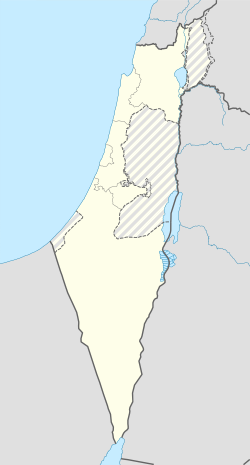Top Qs
Timeline
Chat
Perspective
Horvat 'Anim
Archaeological site at Lower Ghuwein in Israel From Wikipedia, the free encyclopedia
Remove ads
Horvat ʽAnim (Hebrew: חורבת ענים) or Khirbet Ghuwein al-Tahta (Arabic: خربة غويين التحتا, “Lower Ghuwein”) is a ruined hamlet and archaeological locality in the southern fringes of the Hebron Hills, within Israel’s Southern District, inside the Yatir Forest. The site is identified with the lower of the two historical settlements known as Anim/Anaia from Biblical times and Late Antiquity and preserves the remains of the Anim Synagogue.[1][2][3][4][5]
Remove ads
Geography
Lower ʽAnim lies on a rocky hill within the Yattir uplands at the northern edge of the Negev. The ruins area is studded with caves, water cisterns, stone fences, and rock-cut installations typical of dry-farming landscapes in the southern Judean hills.[6]
History
Scholars identify Lower ʽAnim with the Jewish settlement mentioned by Eusebius as Anaia, pairing it with a Christian counterpart at Upper ʽAnim (Arabic: Khirbet Ghuwein al-Fauqa) nearby.[7] The site preserves caves, cisterns and architectural remains that 19th-century explorers described in detail.[8]
Nineteenth-century and early twentieth-century surveys record the location as an Arab hamlet/ruin known as Khirbet Ghuwein et-Tahta (Lower Ghuwein). In 1838, Edward Robinson and noted al-Ghuwein as a ruin located southwest of el-Khulil.[9] In the 1870s, Survey of Western Palestine recorded Khurbet el Ghuwein et Taḥta as consisting of “traces of ruins and caves.”[10]
The surrounding area formed part of the southern Hebron/Judean hills rural economy based on field crops, cisterns and seasonal cave dwellings.[11][12]
Following 1949, the site has lain within Israel and today is encompassed by the Yatir Forest recreational area; the ruins are accessible by marked trails.[13]
Remove ads
Anim Synagogue
Archaeological remains of a rectangular, basilical synagogue (approx. 14.5 × 8.5 m) date its main phase to the 4th–7th centuries CE, with later conversion to a mosque in the early Islamic period. Excavations by Z. Ilan and Dan Urman (1988–89) reported standing hewn-stone walls to c. 3.5 m, an eastern entrance with preserved lintels, traces of a mosaic pavement beneath a later stone floor, and inscription fragments.[14][15] The synagogue at Lower ʽAnim is paired historically with a Byzantine-era church on the hill east of Upper ʽAnim, reflecting the Christianisation patterns of the South Hebron Hills in Late Antiquity.[16][17]
Palestinian hamlet (Khirbet Ghuwein al-Tahta)
Historical surveys list the locus as an Arab hamlet/ruin (khirbet) named Khirbet Ghuwein et-Tahta (Lower Ghuwein). Remains include rock-hewn cisterns, terraces and caves indicative of seasonal agro-pastoral use; the site today is uninhabited within Yatir Forest.[18][19][20]
See also
- Khirbet Ghuwein al-Fauqa – the upper (Fauqa) hamlet 2–5 km to the northeast
- Masafer Yatta – wider South Hebron Hills context
References
External links
Wikiwand - on
Seamless Wikipedia browsing. On steroids.
Remove ads



